Isothermal and Non-Isothermal Crystallization Studies of Long Chain Branched Polypropylene Containing Poly(ethylene-co-octene) under Quiescent and Shear Conditions
Abstract
:1. Introduction
2. Materials and Methods
2.1. Materials
2.2. Preparation of LCB PP
2.3. Preparation of LCB PP/PEOc Blends
2.4. Polarized Optical Microscopy (POM)
2.5. Differential Scanning Calorimetry (DSC)
2.6. Rheological Measurements
2.7. Scanning Electron Microscopy (SEM)
3. Results and Discussion
3.1. POM Observations
3.2. Isothermal Dynamic Rheological Experiments
3.3. Isothermal DSC Measurements
3.4. Non-Isothermal DSC Measurements
3.5. Non-Isothermal Steady Shear Rheological Experiments
3.6. Morphology Observations
4. Conclusions
Acknowledgments
Author Contributions
Conflicts of Interest
References
- Ghijsels, A.; de Clippeleir, J. Melt strength behaviour of polypropylenes. Int. Polym. Proc. 1994, 9, 252–257. [Google Scholar] [CrossRef]
- Yoshii, F.; Makuuchi, K.; Kikukawa, S. High-melt-strength polypropylene with electron beam irradiation in the presence of polyfunctional monomers. J. Appl. Polym. Sci. 1996, 60, 617–623. [Google Scholar] [CrossRef]
- Lagendijk, R.P.; Hogt, A.H.; Buijtenhuijs, A.; Gotsis, A.D. Peroxydicarbonate modification of polypropylene and extensional flow properties. Polymer 2001, 42, 10035–10043. [Google Scholar] [CrossRef]
- Wang, L.; Wan, D.; Zhang, Z.J.; Liu, F.; Xing, H.P.; Wang, Y.H.; Tang, T. Synthesis and structure-property relationships of polypropylene-g-poly(ethylene-co-1-butene) graft copolymers with well-defined long chain branched molecular structures. Macromolecules 2011, 44, 4167–4179. [Google Scholar] [CrossRef]
- Wang, X.; Tzoganakis, C.; Rempel, G.L. Chemical modification of polypropylene with peroxide/pentaerythritol triacrylate by reactive extrusion. J. Appl. Polym. Sci. 1996, 61, 1395–1404. [Google Scholar] [CrossRef]
- Graebling, D. Synthesis of branched polypropylene by a reactive extrusion process. Macromolecules 2002, 35, 4602–4610. [Google Scholar] [CrossRef]
- Tian, J.H.; Yu, W.; Zhou, C.X. The preparation and rheology characterization of long chain branching polypropylene. Polymer 2006, 47, 7962–7969. [Google Scholar] [CrossRef]
- Yu, F.Y.; Zhang, H.B.; Liao, R.G.; Zheng, H.; Yu, W.; Zhou, C.X. Flow induced crystallization of long chain branched polypropylenes under weak shear flow. Eur. Polym. J. 2009, 45, 2110–2118. [Google Scholar] [CrossRef]
- Parent, J.S.; Bodsworth, A.; Sengupta, S.S.; Kontopoulou, M.; Chaudhary, B.I.; Poche, D.; Cousteaux, S. Structure-rheology relationships of long-chain branched polypropylene: Comparative analysis of acrylic and allylic coagent chemistry. Polymer 2009, 50, 85–94. [Google Scholar] [CrossRef]
- El Mabrouk, K.; Parent, J.S.; Chaudhary, B.I.; Cong, R.J. Chemical modification of PP architecture: Strategies for introducing long-chain branching. Polymer 2009, 50, 5390–5397. [Google Scholar] [CrossRef]
- Li, S.Z.; Xiao, M.M.; Wei, D.F.; Xiao, H.N.; Hu, F.Z.; Zheng, A.N. The melt grafting preparation and rheological characterization of long chain branching polypropylene. Polymer 2009, 50, 6121–6128. [Google Scholar] [CrossRef]
- Zhang, Z.J.; Xing, H.P.; Qiu, J.; Jiang, Z.W.; Yu, H.O.; Du, X.H.; Wang, Y.H.; Ma, L.; Tang, T. Controlling melt reactions during preparing long chain branched polypropylene using copper N,N-dimethyldithiocarbamate. Polymer 2010, 51, 1593–1598. [Google Scholar] [CrossRef]
- Auhl, D.; Stange, J.; Munstedt, H.; Krause, B.; Voigt, D.; Lederer, A.; Lappan, U.; Lunkwitz, K. Long-chain branched polypropylenes by electron beam irradiation and their rheological properties. Macromolecules 2004, 37, 9465–9472. [Google Scholar] [CrossRef]
- Krause, B.; Stephan, M.; Volkland, S.; Voigt, D.; Haussler, L.; Dorschner, H. Long-chain branching of polypropylene by electron-beam irradiation in the molten state. J. Appl. Polym. Sci. 2006, 99, 260–265. [Google Scholar] [CrossRef]
- Chiu, W.-Y.; Fang, S.-J. Mechanical properties and morphology of crosslinked PP/PE blends and PP/PE/propylene-ethylene copolymer blends. J. Appl. Polym. Sci. 1985, 30, 1473–1489. [Google Scholar] [CrossRef]
- Kim, G.M.; Michler, G.H.; Gahleitner, M.; Fiebig, J. Relationship between morphology and micromechanical toughening mechanisms in modified polypropylenes. J. Appl. Polym. Sci. 1996, 60, 1391–1403. [Google Scholar] [CrossRef]
- Kotter, I.; Grellmann, W.; Koch, T.; Seidler, S. Morphology-toughness correlation of polypropylene/ethylene-propylene rubber blends. J. Appl. Polym. Sci. 2006, 100, 3364–3371. [Google Scholar] [CrossRef]
- Choudhary, V.; Varma, H.S.; Varma, I.K. Polyolefin blends: Effect of EPDM rubber on crystallization, morphology and mechanical properties of polypropylene/EPDM blends. 1. Polymer 1991, 32, 2534–2540. [Google Scholar] [CrossRef]
- D’Orazio, L.; Mancarella, C.; Martuscelli, E.; Sticotti, G.; Massari, P. Melt rheology, phase structure and impact properties of injection-moulded samples of isotactic polypropylene/ethylene-propylene copolymer (iPP/EPR) blends: Influence of molecular structure of EPR copolymers. Polymer 1993, 34, 3671–3681. [Google Scholar] [CrossRef]
- Chen, C.Y.; Yunus, W.M.Z.W.; Chiu, H.W.; Kyu, T. Phase separation behaviour in blends of isotactic polypropylene and ethylene-propylene diene terpolymer. Polymer 1997, 38, 4433–4438. [Google Scholar] [CrossRef]
- Van der Wal, A.; Mulder, J.J.; Oderkerk, J.; Gaymans, R.J. Polypropylene-rubber blends: 1. The effect of the matrix properties on the impact behaviour. Polymer 1998, 39, 6781–6787. [Google Scholar] [CrossRef]
- Van der Wal, A.; Gaymans, R.J. Polypropylene-rubber blends: 5. Deformation mechanism during fracture. Polymer 1999, 40, 6067–6075. [Google Scholar] [CrossRef]
- Gupta, A.K.; Purwar, S.N. Crystallization of PP in PP/SEBS blends and its correlation with tensile properties. J. Appl. Polym. Sci. 1984, 29, 1595–1609. [Google Scholar] [CrossRef]
- Stricker, F.; Thomann, Y.; Mülhaupt, R. Influence of rubber particle size on mechanical properties of polypropylene-SEBS blends. J. Appl. Polym. Sci. 1998, 68, 1891–1901. [Google Scholar] [CrossRef]
- Mäder, D.; Bruch, M.; Maier, R.-D.; Stricker, F.; Mülhaupt, R. Glass transition temperature depression of elastomers blended with poly(propene)s of different stereoregularities. Macromolecules 1999, 32, 1252–1259. [Google Scholar] [CrossRef]
- Bassani, A.; Pessan, L.A. Toughening of polypropylene with styrene/ethylene-butylene/styrene tri-block copolymer: Effects of reactive and nonreactive compatibilization. J. Appl. Polym. Sci. 2002, 86, 3466–3479. [Google Scholar] [CrossRef]
- Abreu, F.O.M.S.; Forte, M.M.C.; Liberman, S.A. SBS and SEBS block copolymers as impact modifiers for polypropylene compounds. J. Appl. Polym. Sci. 2005, 95, 254–263. [Google Scholar] [CrossRef]
- Hong, C.H.; Lee, Y.B.; Bae, J.W.; Jho, J.Y.; Nam, B.U.; Chang, D.-H.; Yoon, S.-H.; Lee, K.-J. Tensile properties and stress whitening of polypropylene/polyolefin elastomer/magnesium hydroxide flame retardant composites for cable insulating application. J. Appl. Polym. Sci. 2005, 97, 2311–2318. [Google Scholar] [CrossRef]
- Lim, J.W.; Hassan, A.; Rahmat, A.R.; Wahit, M.U. Rubber-toughened polypropylene nanocomposite: Effect of polyethylene octene copolymer on mechanical properties and phase morphology. J. Appl. Polym. Sci. 2006, 99, 3441–3450. [Google Scholar] [CrossRef]
- Da Silva, A.L.N.; Tavares, M.I.B.; Politano, D.P.; Coutinho, F.M.B.; Rocha, M.C.G. Polymer blends based on polyolefin elastomer and polypropylene. J. Appl. Polym. Sci. 1997, 66, 2005–2014. [Google Scholar] [CrossRef]
- Hom, S.; Bhattacharyya, A.R.; Khare, R.A.; Kulkarni, A.R.; Saroop, M.; Biswas, A. Blends of polypropylene and ethylene octene comonomer with conducting fillers: Influence of state of dispersion of conducting fillers on electrical conductivity. Polym. Eng. Sci. 2009, 49, 1502–1510. [Google Scholar] [CrossRef]
- McNally, T.; McShane, P.; Nally, G.M.; Murphy, W.R.; Cook, M.; Miller, A. Rheology, phase morphology, mechanical, impact and thermal properties of polypropylene/metallocene catalysed ethylene 1-octene copolymer blends. Polymer 2002, 43, 3785–3793. [Google Scholar] [CrossRef]
- Zhou, H.M.; Ying, J.R.; Liu, F.; Xie, X.L.; Li, D.Q. Non-isothermal crystallization behaviour and kinetics of isotactic polypropylene/ethylene-octene blends. Part I: Crystallization behaviour. Polym. Test. 2010, 29, 640–647. [Google Scholar] [CrossRef]
- Tang, W.H.; Tang, J.; Yuan, H.L.; Jin, R.G. Crystallization behaviour and mechanical properties of polypropylene random copolymer/poly(ethylene-octene) blends. J. Appl. Polym. Sci. 2011, 122, 461–468. [Google Scholar] [CrossRef]
- Yang, J.H.; Zhang, Y.; Zhang, Y.X. Brittle-ductile transition of PP/POE blends in both impact and high speed tensile tests. Polymer 2003, 44, 5047–5052. [Google Scholar] [CrossRef]
- Zhang, L.; Huang, R.; Li, L.B.; Wang, G. Effect of fibrillar morphology on elastomer-modified polypropylene. J. Appl. Polym. Sci. 2002, 83, 1870–1874. [Google Scholar]
- Nofar, M.; Zhu, W.L.; Park, C.B.; Randall, J. Crystallization kinetics of linear and long-chain-branched polylactide. Ind. Eng. Chem. Res. 2011, 50, 13789–13798. [Google Scholar] [CrossRef]
- Ouintana, R.; de Ilarduya, A.M.; Guerra, S.M.; Fernandez, M.; Munoz, M.E.; Santamaria, A. Rheological features and flow-induced crystallization of branched poly ethylene-co-(1,4-cyclohexanedimethylene terephthalate) copolyesters. Macromol. Mater. Eng. 2008, 293, 836–846. [Google Scholar] [CrossRef]
- Zhai, W.T.; Yu, J.; Ma, W.M.; He, J.S. Influence of long-chain branching on the crystallization and melting behaviour of polycarbonates in supercritical CO2. Macromolecules 2007, 40, 73–80. [Google Scholar] [CrossRef]
- Meng, K.; Dong, X.; Zhang, X.H.; Zhang, C.G.; Han, C.C. Shear-induced crystallization in a blend of isotactic poly(propylene) and poly (ethylene-co-octene). Macromol. Rapid. Commun. 2006, 27, 1677–1683. [Google Scholar] [CrossRef]
- Meng, K.; Dong, X.; Hong, S.; Wang, X.; Cheng, H.; Han, C.C. Shear-induced crystallization in phase-separated blend of isotactic polypropylene and poly (ethylene-co-octene). J. Chem. Phys. 2008, 128, 024906. [Google Scholar] [CrossRef] [PubMed]
- Ying, J.R.; Liu, S.P.; Guo, F.; Zhou, X.P.; Xie, X.L. Non-isothermal crystallization and crystalline structure of PP/POE blends. J. Therm. Anal. Calorim. 2008, 91, 723–731. [Google Scholar] [CrossRef]
- Svoboda, P.; Svobodova, D.; Slobodian, P.; Ougizawa, T.; Inoue, T. Crystallization kinetics of polypropylene/ethylene-octene copolymer blends. Polym. Test. 2009, 28, 215–222. [Google Scholar] [CrossRef]
- Svoboda, P.; Trivedi, K.; Svobodova, D.; Mokrejs, P.; Vasek, V.; Mori, K.; Ougizawa, T.; Inoue, T. Isothermal crystallization in polypropylene/ethylene-octene copolymer blends. Mater. Chem. Phys. 2011, 131, 84–93. [Google Scholar] [CrossRef]
- Yu, F.Y.; Zhang, Z.N.; Yu, W.; Zhou, C.X.; Zhang, H.B. Modeling of flow-induced crystallization in blends of isotactic polypropylene and poly(ethylene-co-octene). Polym. Int. 2012, 61, 1389–1393. [Google Scholar] [CrossRef]
- Yu, F.Y.; Zhang, H.B.; Zheng, H.; Yu, W.; Zhou, C.X. Experimental study of flow-induced crystallization in the blends of isotactic polypropylene and poly(ethylene-co-octene). Eur. Polym. J. 2008, 44, 79–86. [Google Scholar] [CrossRef]
- Acierno, S.; Coppola, S.; Grizzuti, N.; Maffettone, P.L. Coupling between kinetics and rheological parameters in the flow-induced crystallization of thermoplastic polymers. Macromol. Symp. 2002, 185, 233–241. [Google Scholar] [CrossRef]
- Agarwal, P.K.; Somani, R.H.; Weng, W.Q.; Mehta, A.; Yang, L.; Ran, S.F.; Liu, L.Z.; Hsiao, B.S. Shear-induced crystallization in novel long chain branched polypropylenes by in situ rheo-SAXS and -WAXD. Macromolecules 2003, 36, 5226–5235. [Google Scholar] [CrossRef]
- Doufas, A.K.; Dairanieh, I.S.; McHugh, A.J. A continuum model for flow-induced crystallization of polymer melts. J. Rheol. 1999, 43, 85–109. [Google Scholar] [CrossRef]
- Janeschitz-Kriegl, H.; Ratajski, E.; Stadlbauer, M. Flow as an effective promotor of nucleation in polymer melts: A quantitative evaluation. Rheol. Acta 2003, 42, 355–364. [Google Scholar] [CrossRef]
- Yu, F.Y.; Zhang, H.B. Fourier-transform rheology studies on the crystallization of isotactic polypropylene in non-linear large strain oscillation shear fields. Acta Polym. Sin. 2010, 3, 372–376. [Google Scholar] [CrossRef]
- Yu, F.Y.; Zhang, H.B.; Wang, Z.; Yu, W.; Zhou, C. Effects of stress overshoot on the flow-induced crystallization of polymeric melt. Chin. J. Polym. Sci. 2010, 28, 657–666. [Google Scholar] [CrossRef]
- Yu, F.Y.; Zhang, H.B.; Wang, Z.G.; Yu, W.; Zhou, C.X. Prediction of the Flow-induced Crystallization in High-Density Polyethylene by a Continuum Model. J. Polym. Sci. Polym. Phys. 2009, 47, 531–538. [Google Scholar] [CrossRef]
- Palierne, J.F. Linear rheology of viscoelastic emulsions with interfacial tension. Rheol. Acta 1990, 29, 204–214. [Google Scholar] [CrossRef]
- Avrami, M. Granulation, Phase change, and microstructure kinetics of phase change. III. J. Chem. Phys. 1941, 9, 177–184. [Google Scholar] [CrossRef]
- Avrami, M. Kinetics of phase change. II transformation-time relations for random distribution of nuclei. J. Chem. Phys. 1940, 8, 212–224. [Google Scholar] [CrossRef]
- Avrami, M. Kinetics of phase change. I general theory. J. Chem. Phys. 1939, 7, 1103–1112. [Google Scholar] [CrossRef]
- Gedde, U.W. Polymer Physics; Chapman and Hall: London, UK, 1995. [Google Scholar]
- Graebling, D.; Muller, R.; Palierne, J.F. Linear viscoelastic behaviour of some incompatible polymer blends in the melt. Interpretation of data with a model of emulsion of viscoelastic liquids. Macromolecules 1993, 26, 320–329. [Google Scholar] [CrossRef]
- Carriere, C.J.; Silvis, H.C. The effects of short-chain branching and comonomer type on the interfacial tension of polypropylene-polyolefin elastomer blends. J. Appl. Polym. Sci. 1997, 66, 1175–1181. [Google Scholar] [CrossRef]
- Kontopoulou, M.; Wang, W.; Gopakumar, T.G.; Cheung, C. Effect of composition and comonomer type on the rheology, morphology and properties of ethylene-alpha-olefin copolymer/polypropylene blends. Polymer 2003, 44, 7495–7504. [Google Scholar] [CrossRef]
- Kamal, M.R.; Demarquette, N.R.; LaiFook, R.A.; Price, T.A. Evaluation of thermodynamic theories to predict interfacial tension between polystyrene and polypropylene melts. Polym. Eng. Sci. 1997, 37, 813–825. [Google Scholar] [CrossRef]
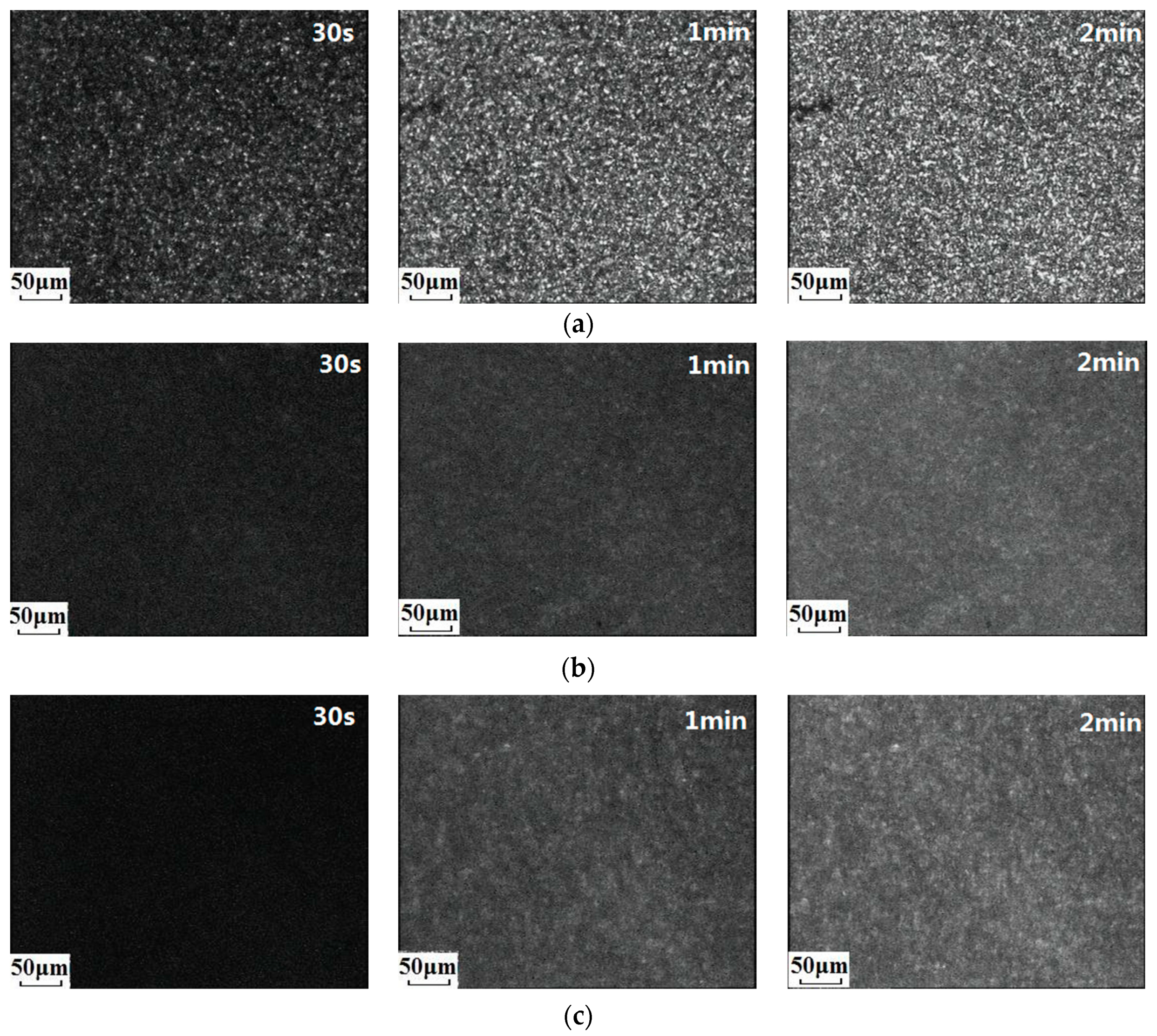
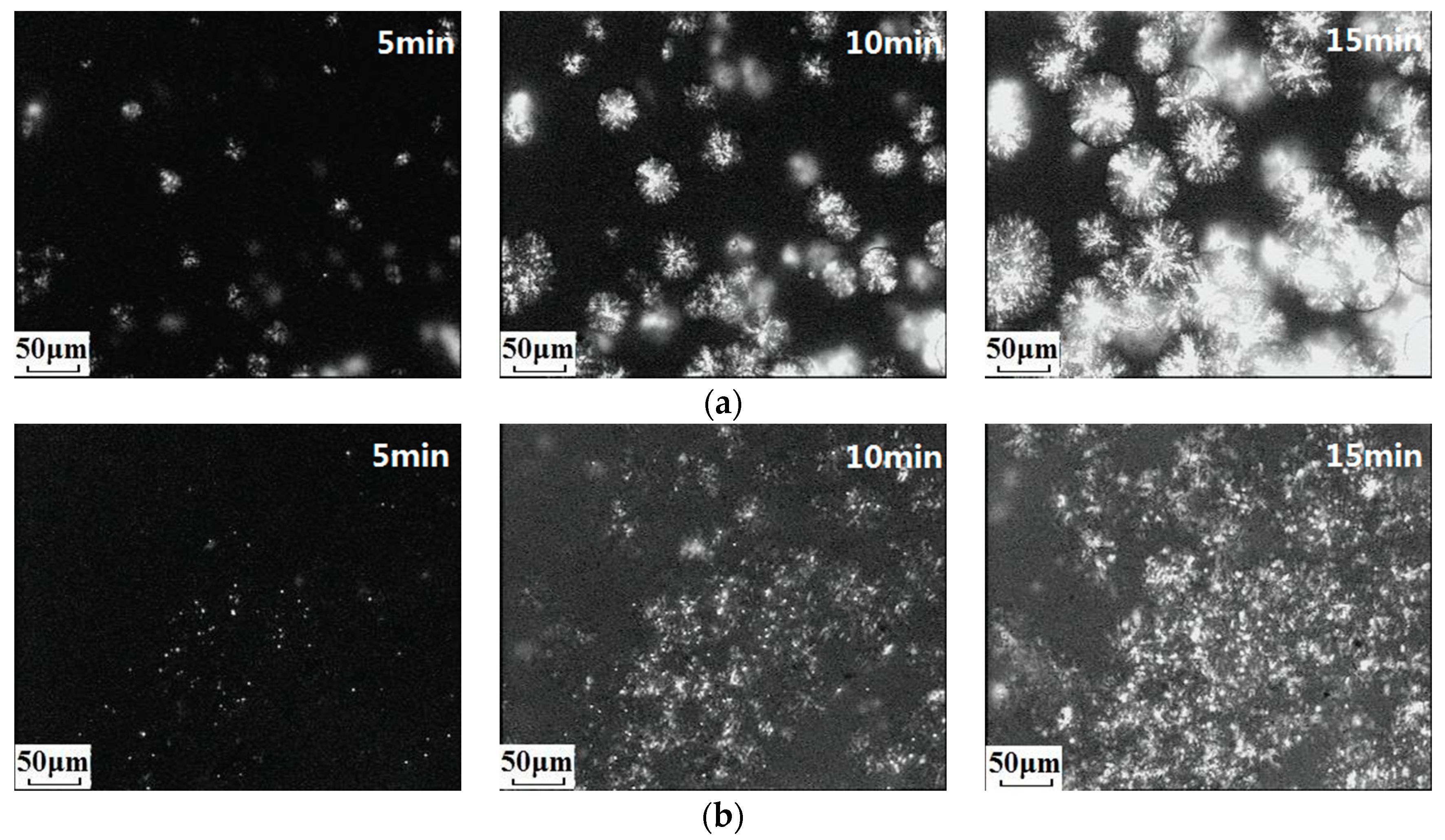
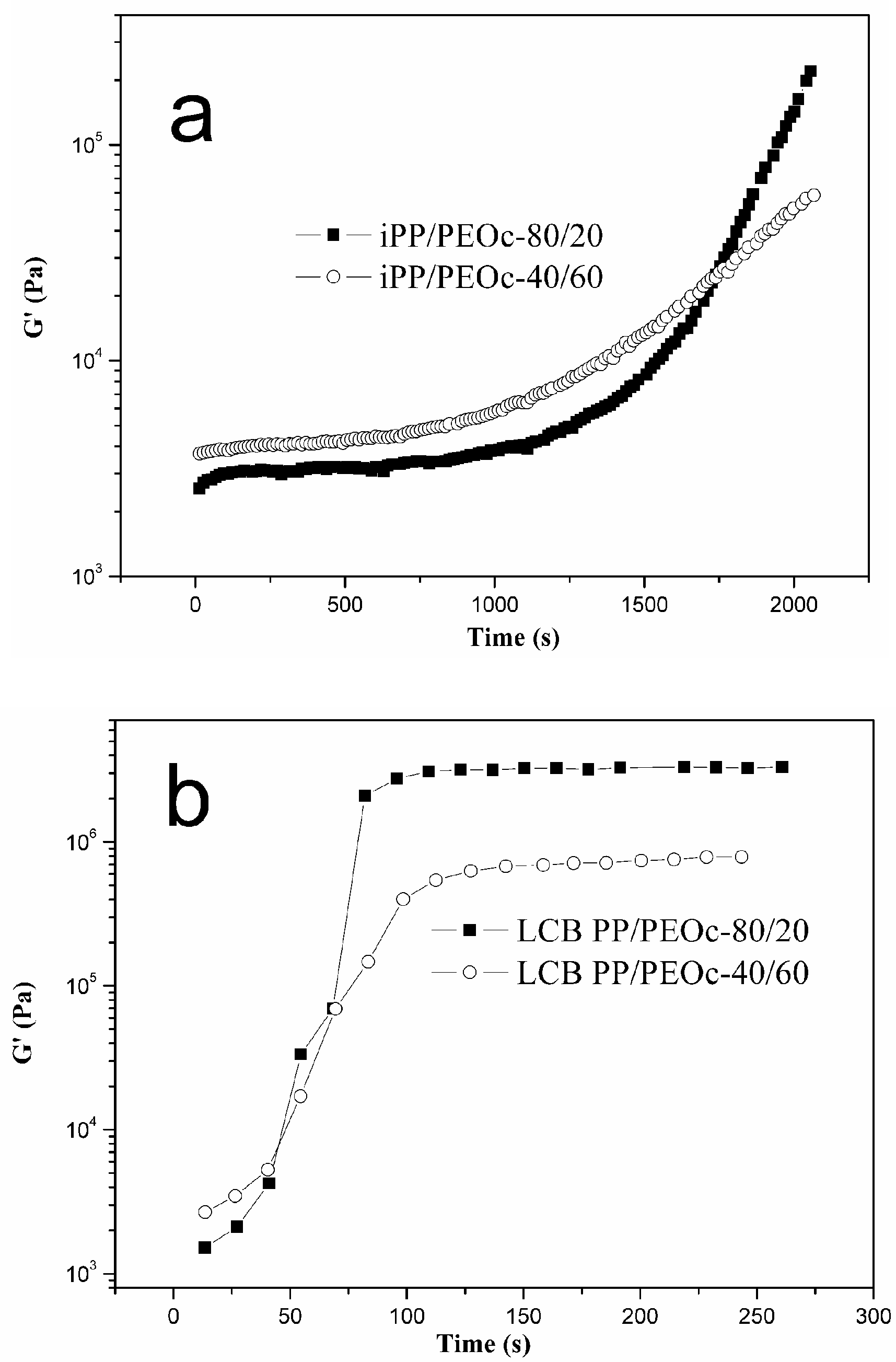
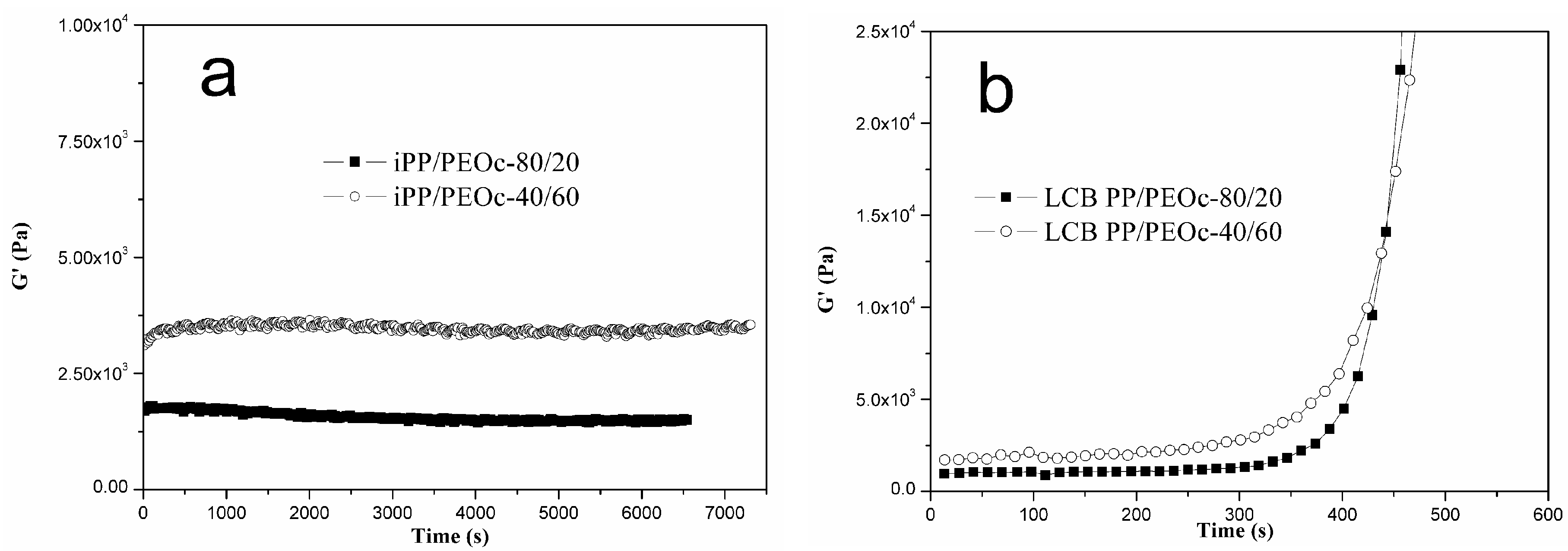
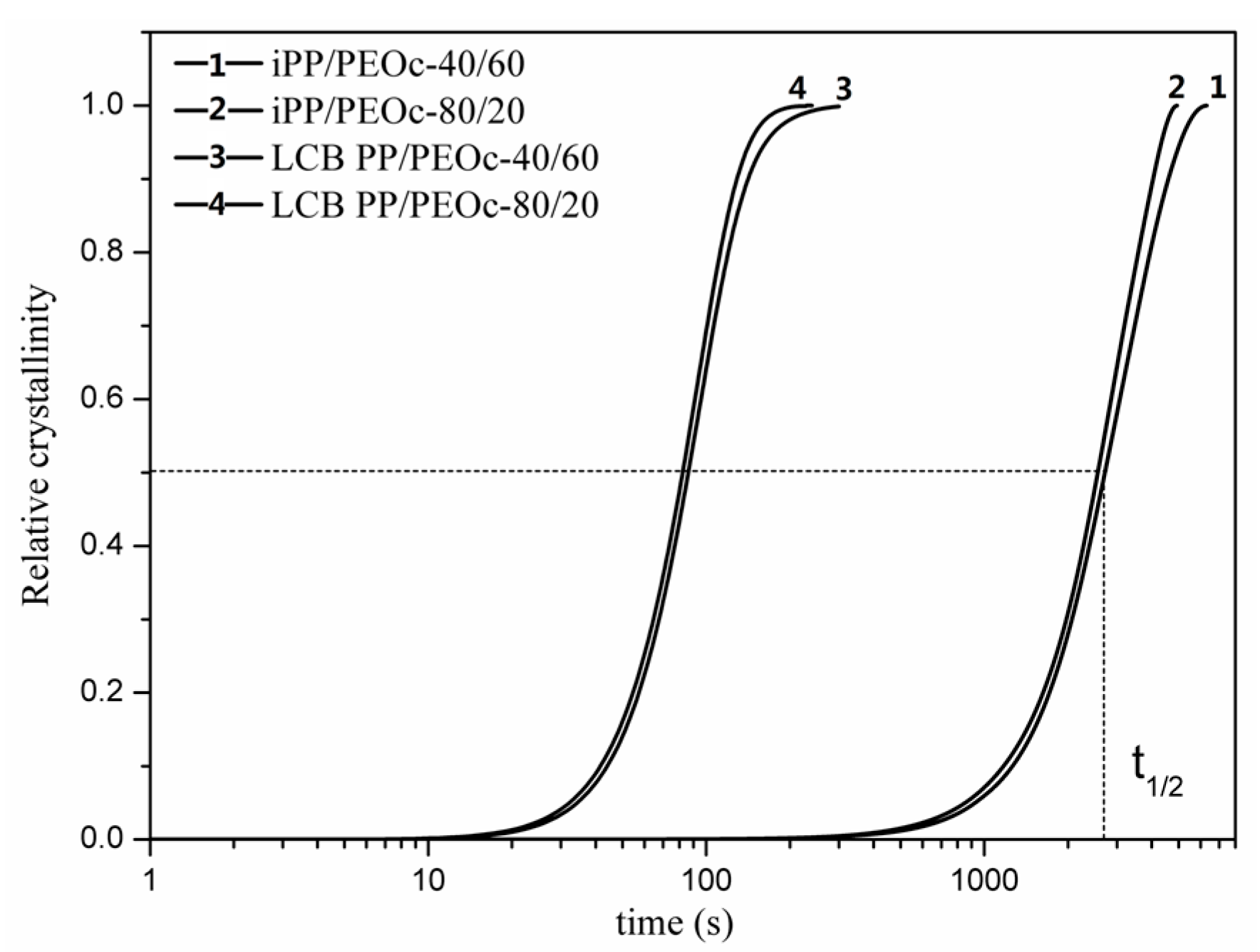

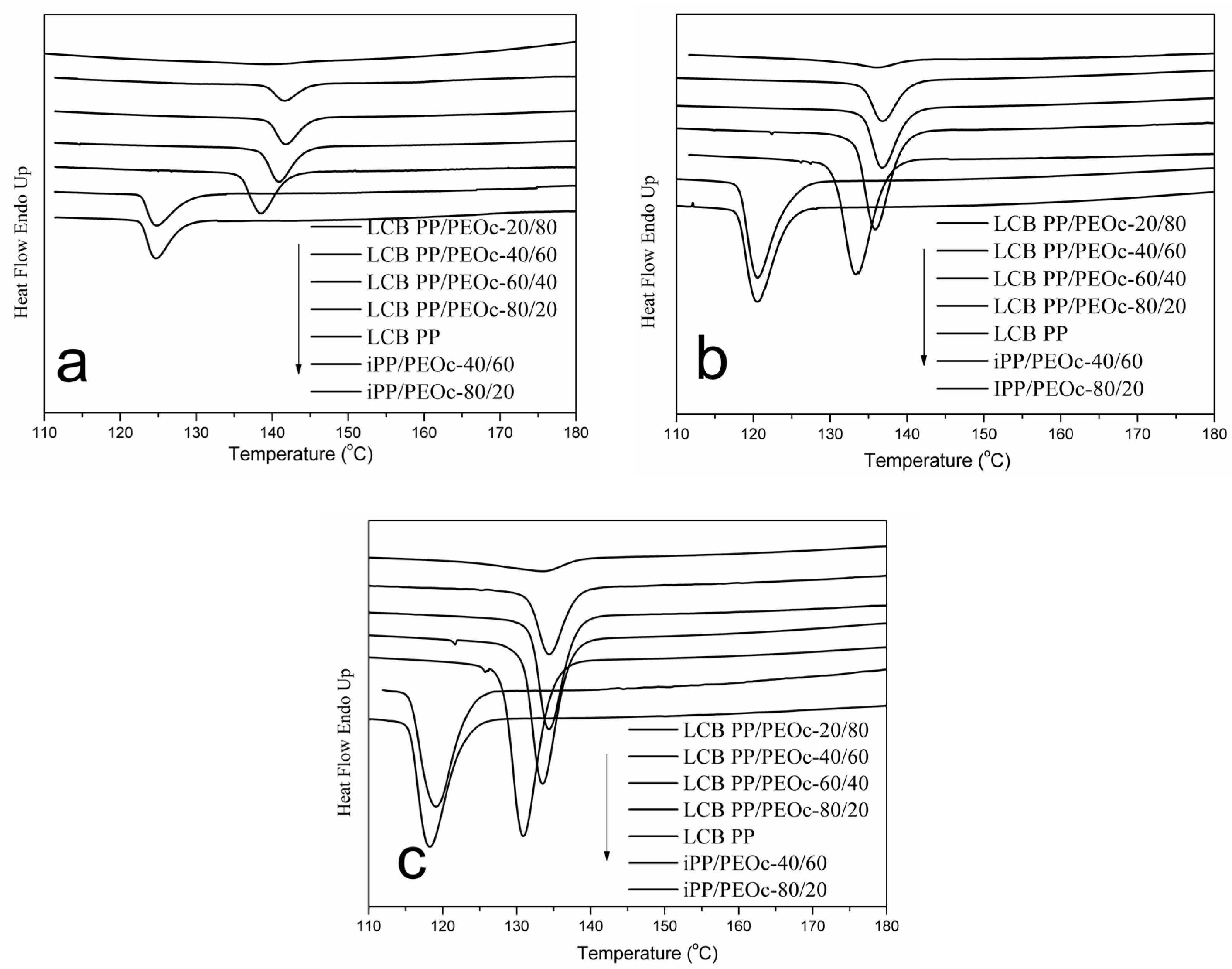
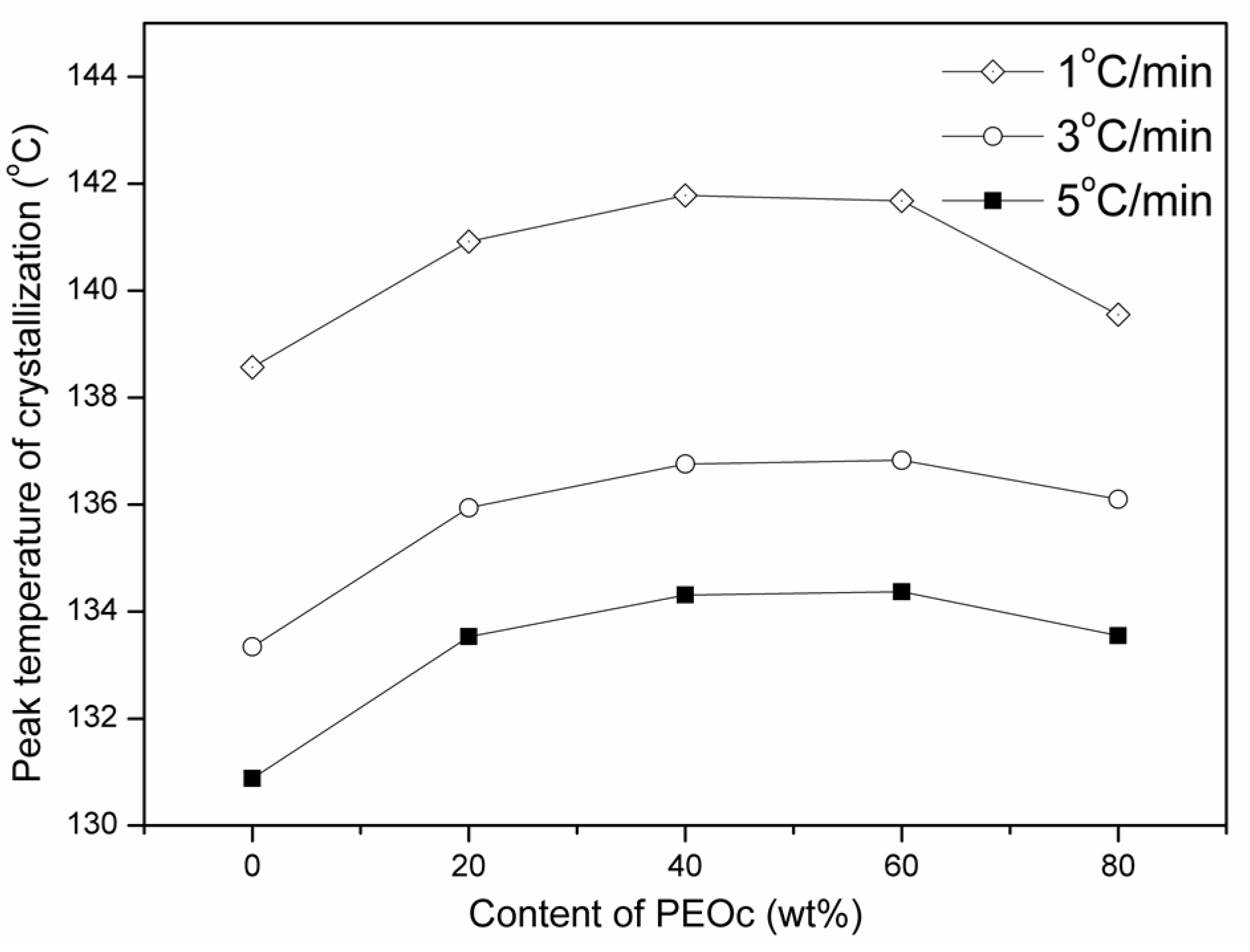
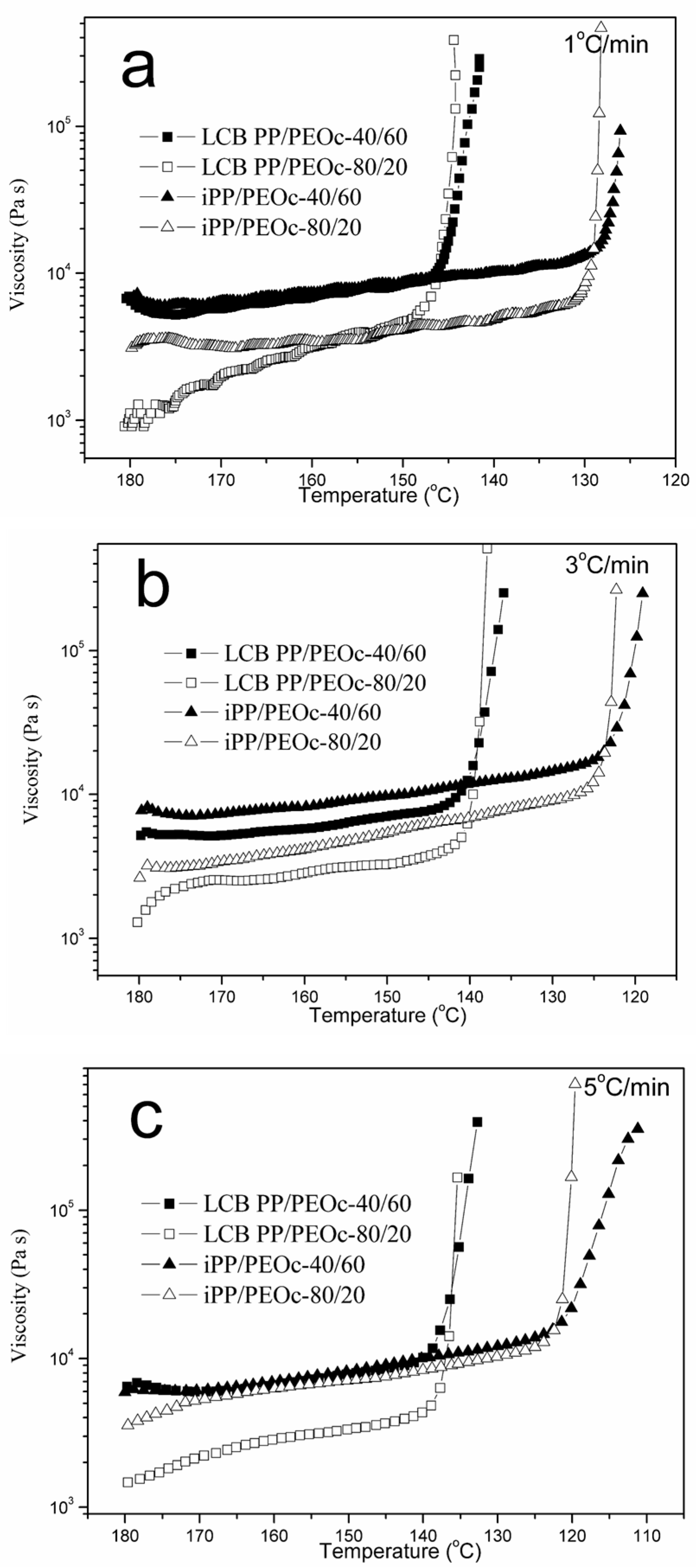
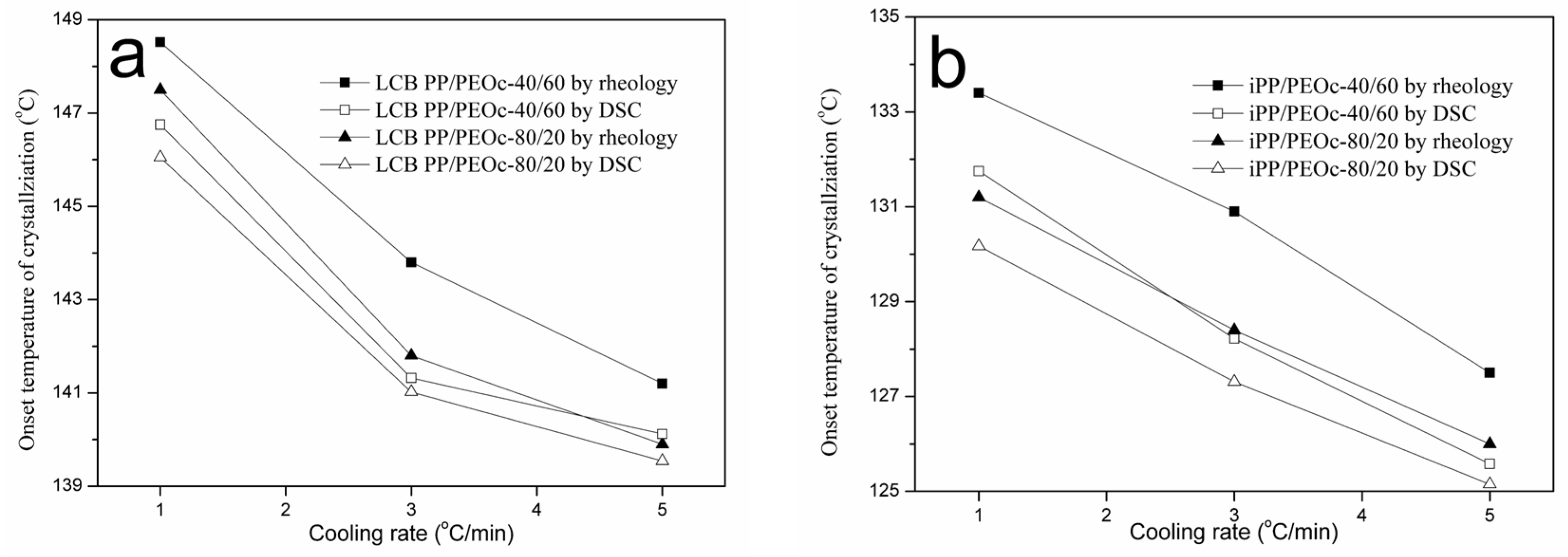
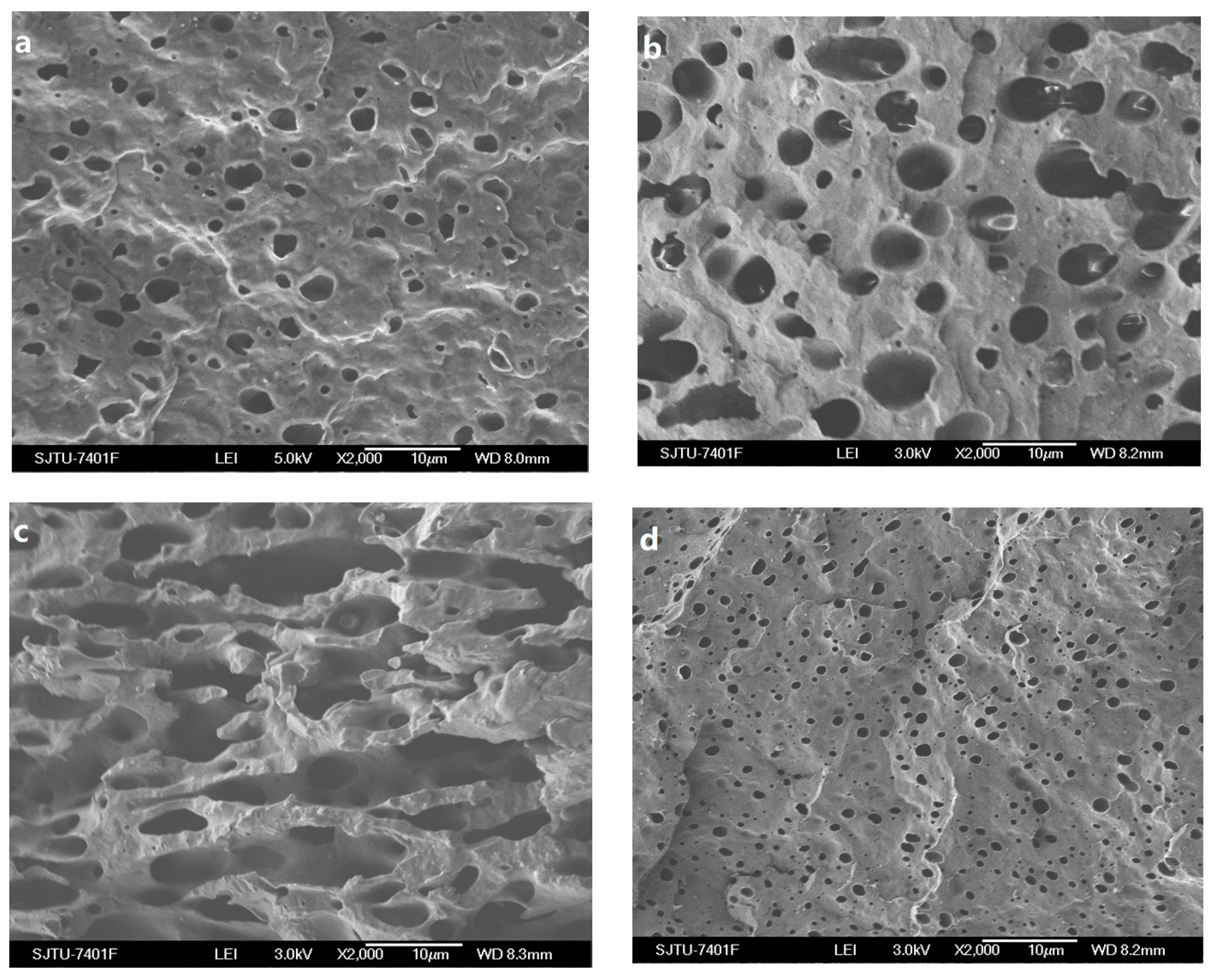

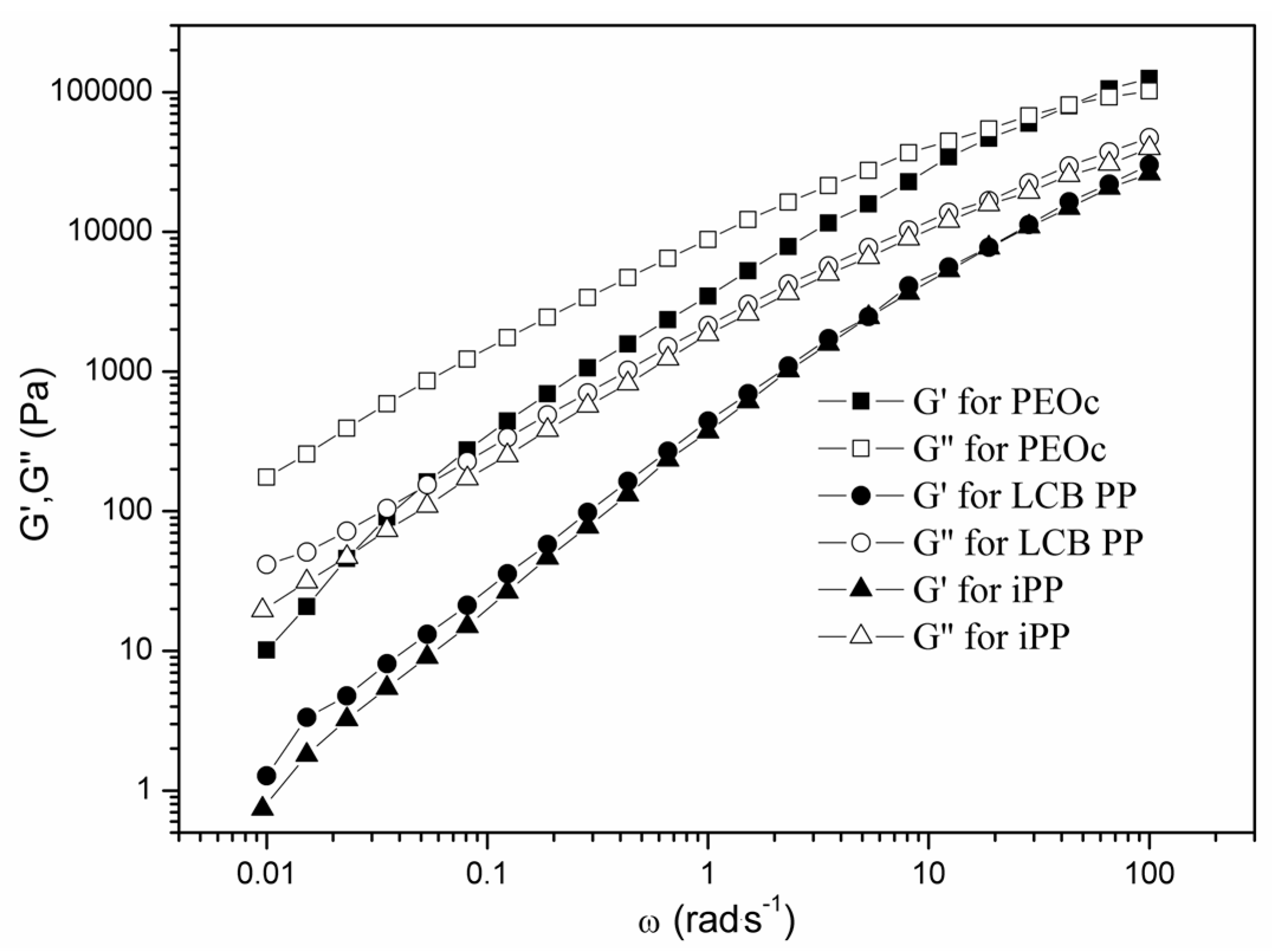

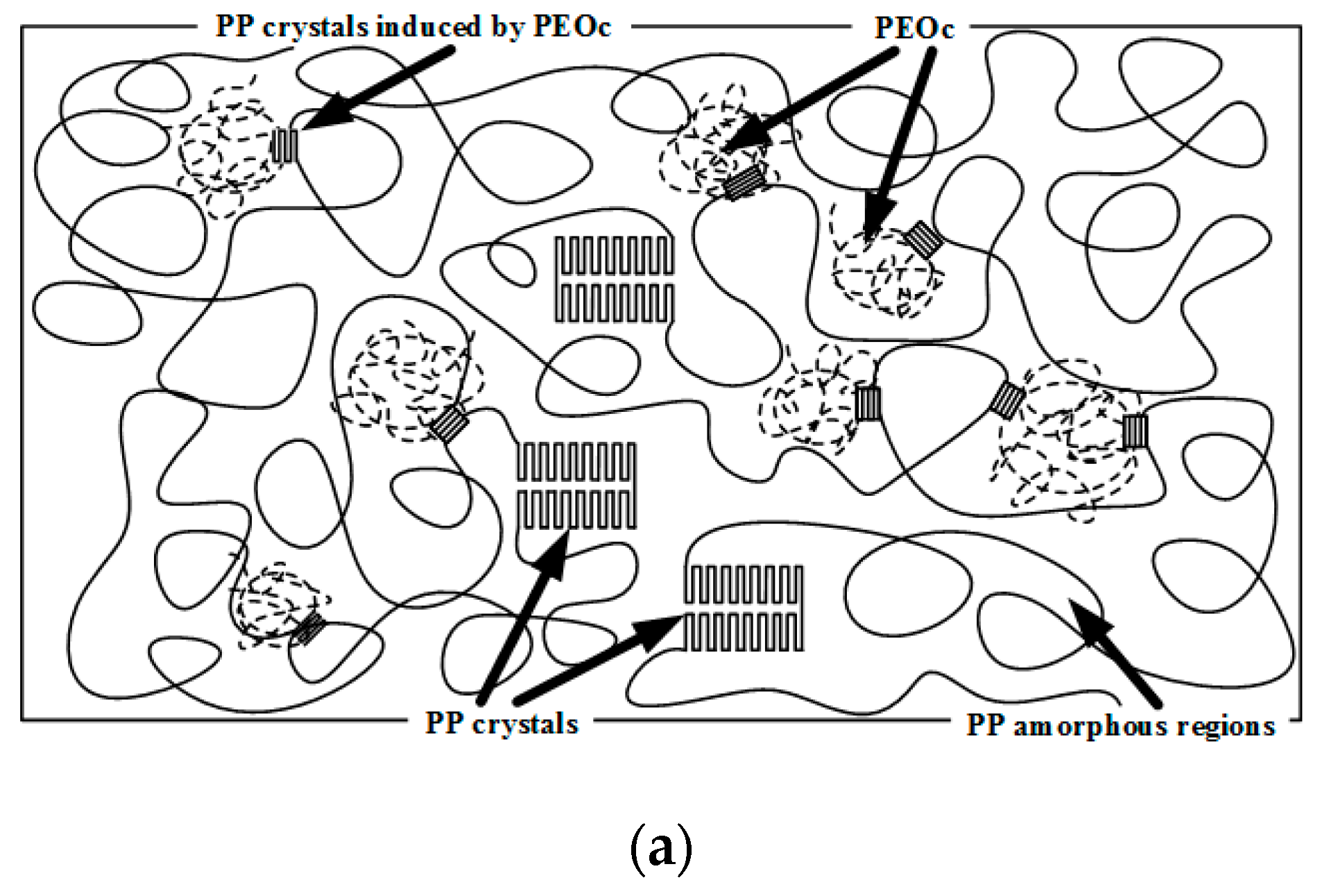
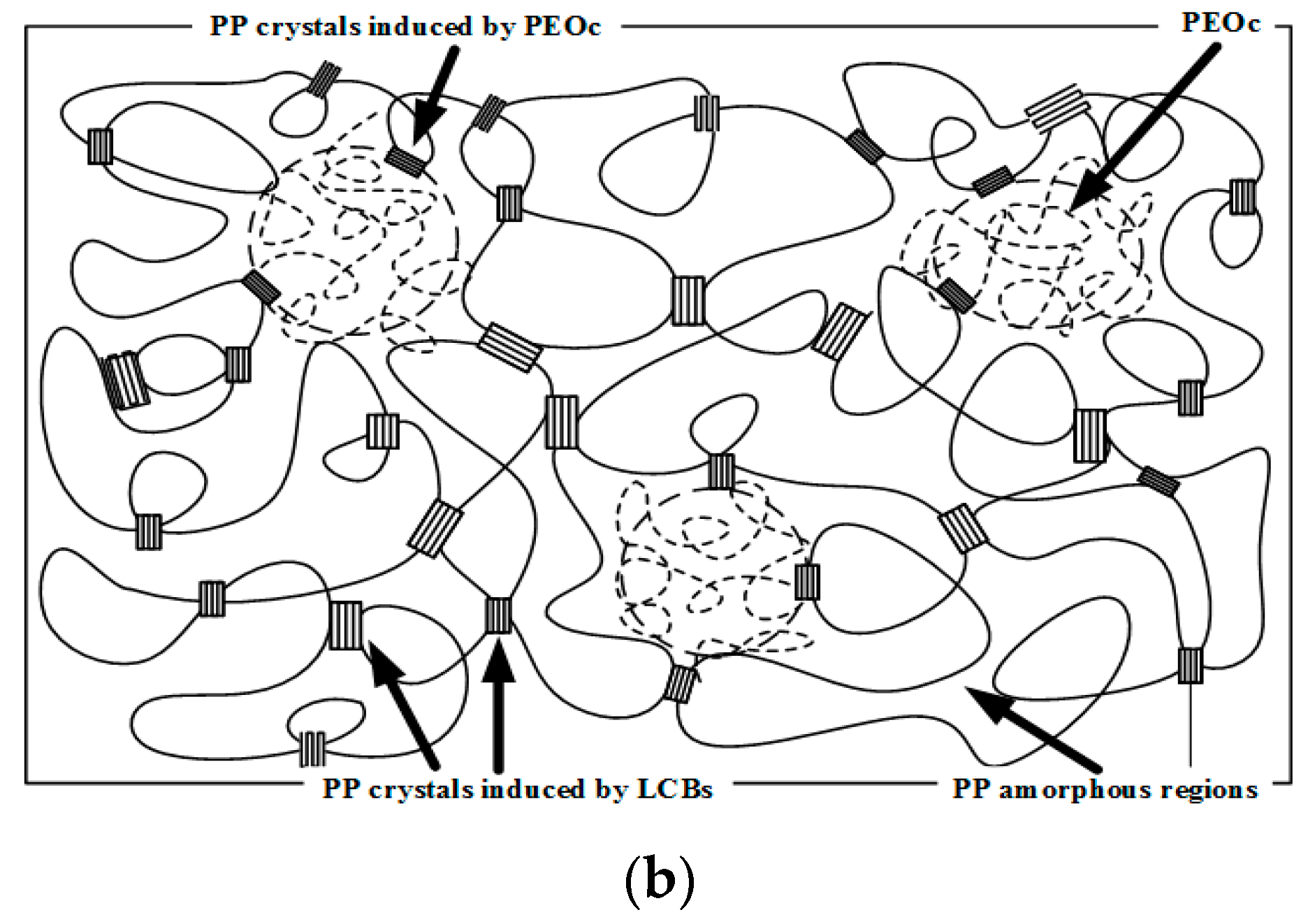
| Sample | t1/2 (s) | n | k × 109 (s−1) |
|---|---|---|---|
| iPP/PEOc-80/20 | 2556 | 2.35 | 7.85 |
| iPP/PEOc-40/60 | 2712 | 2.33 | 5.67 |
| LCB PP/PEOc-80/20 | 83 | 2.80 | 3371 |
| LCB PP/PEOc-40/60 | 87 | 2.77 | 2529 |
| Sample | ϕ | R (μm) | τ (mN m−1) |
|---|---|---|---|
| iPP/PEOc-80/20 | 0.208 | 0.7 | 0.67 |
| iPP/PEOc-60/40 | 0.411 | 0.98 | 0.65 |
| LCB PP/PEOc-80/20 | 0.208 | 1.2 | 0.75 |
| LCB PP/PEOc-60/40 | 0.411 | 3.5 | 0.73 |
© 2017 by the authors. Licensee MDPI, Basel, Switzerland. This article is an open access article distributed under the terms and conditions of the Creative Commons Attribution (CC BY) license (http://creativecommons.org/licenses/by/4.0/).
Share and Cite
Zhang, Z.; Yu, F.; Zhang, H. Isothermal and Non-Isothermal Crystallization Studies of Long Chain Branched Polypropylene Containing Poly(ethylene-co-octene) under Quiescent and Shear Conditions. Polymers 2017, 9, 236. https://doi.org/10.3390/polym9060236
Zhang Z, Yu F, Zhang H. Isothermal and Non-Isothermal Crystallization Studies of Long Chain Branched Polypropylene Containing Poly(ethylene-co-octene) under Quiescent and Shear Conditions. Polymers. 2017; 9(6):236. https://doi.org/10.3390/polym9060236
Chicago/Turabian StyleZhang, Zinan, Fengyuan Yu, and Hongbin Zhang. 2017. "Isothermal and Non-Isothermal Crystallization Studies of Long Chain Branched Polypropylene Containing Poly(ethylene-co-octene) under Quiescent and Shear Conditions" Polymers 9, no. 6: 236. https://doi.org/10.3390/polym9060236





